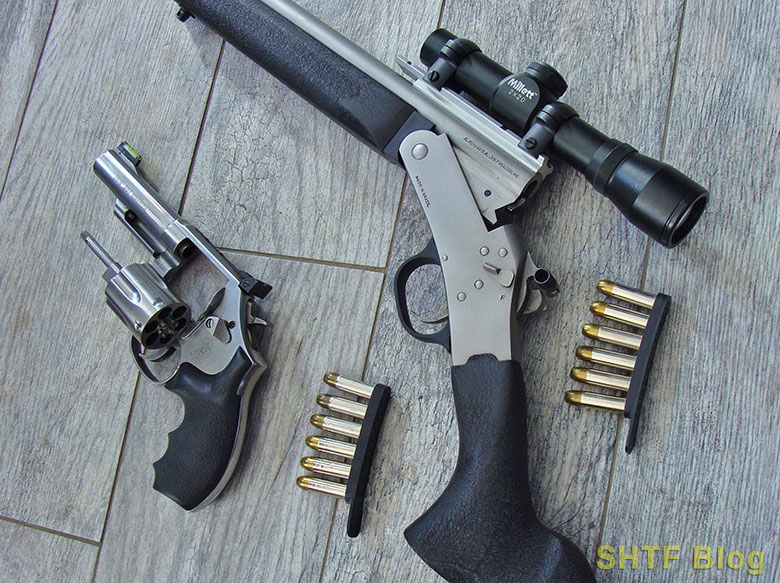
Admittedly, this post is partly for fun. Poking the internet bear, it’ll no doubt elicit contrary responses – and that’s okay as far as I’m concerned. Different strokes for different folks, many of whom face dissimilar situations that dictate varying requirements. A .357 Magnum survival gun, even if stoked to its full potential, wouldn’t be the optimum big game caliber, and it could be a risky choice for those sharing territories with the largest bears.
For that matter, so could the hugely popular .223 Remington/5.56 NATO. Meanwhile, for anyone facing day-to-day survival demands, a growling stomach will be crying out for some sustenance.
Gotta figure, if by design or circumstance, you wind up in the middle of nowhere, opportunities to resupply will be scarce. And pickings will be lean from the start if the location is accessed on foot. In that case, because every ounce matters, essentials become just that; the minimums needed to survive.
Either way, a firearm will top most lists and, for some, another could easily be justified. For many of us, the practical mainstay firearm pick will be a sling-equipped shotgun or rifle. Some of today’s sling systems even free both hands, but a constant state of readiness is better maintained through the inclusion of a holstered handgun.
Off-Grid Options
For maximum versatility, pretty much anywhere short of the most wide-open spaces, it’s hard to beat a 12 gauge shotgun – especially one permitting QD barrel exchanges like a basic Remington or Mossberg pump. A short and handy rifle-sighted barrel stoked with slugs will handle any threat through the largest bears (as well as big game) in North America. A switch to buckshot can nail defense, and the addition of a 26- 28” bird barrel will cover most other hunting needs.
The downsides are mostly space and weight related. Shotgun shells in the all-around gauges (12 or 20 ga.) are relatively large and heavy so, even a single 25-shell box has some heft. That said, such a system could be the practical choice for a single-firearm user, ideally, if deployed from a base location.
Next up rifles – with a rub. Calibers with enough punch to let the air out of large irate critters will reduce more common sources of protein – like squirrels – to a few pre-masticated bites. A .22 LR makes a great small game getter but lacks the steam to address larger targets, whether four or two-legged. Another concern for those on the move is the transportation and preservation of meat.
A windfall deer of average size is none too portable on foot, and it may also be subject to rapid spoilage. On the other hand, a plump grouse constitutes a tasty meal and several, if breasted out, will easily fit in an average pack.
How ‘bout the handgun? A .22 LR handgun could fill a pot with small game or upland birds, and, for that matter, many centerfire revolvers or pistols can do the trick – with the right bullets. However, it’s been my experience (based on years running ranges) that most “shooters” lack the skills to reliably execute such shots. Truth is, that level of accuracy is difficult to master. And each miss translates to less ammo, which won’t be found on trees.
Firearm Realities
The good news: Plenty of shooters are up to the above tasks, using shoulder-fired guns. Heck, many of us have been perforating cans with .22 rifles since our pre-teen years. Go this route and the right choice really boils down to something covering more likely scenarios – preferably, via a common cartridge. Ideally, it’ll suffice for both small and medium-to-larger game species, as well as defense.
As for a handgun, it can still fill a legitimate role. As noted above, if it offers adequate power and is carry-friendly, it can provide an immediate response to a threat, while further serving as a backup firearm (because $%^& happens). And, again, common calibers simplify logistics.
Can we make things even simpler? Perhaps…
Single-Caliber Solutions
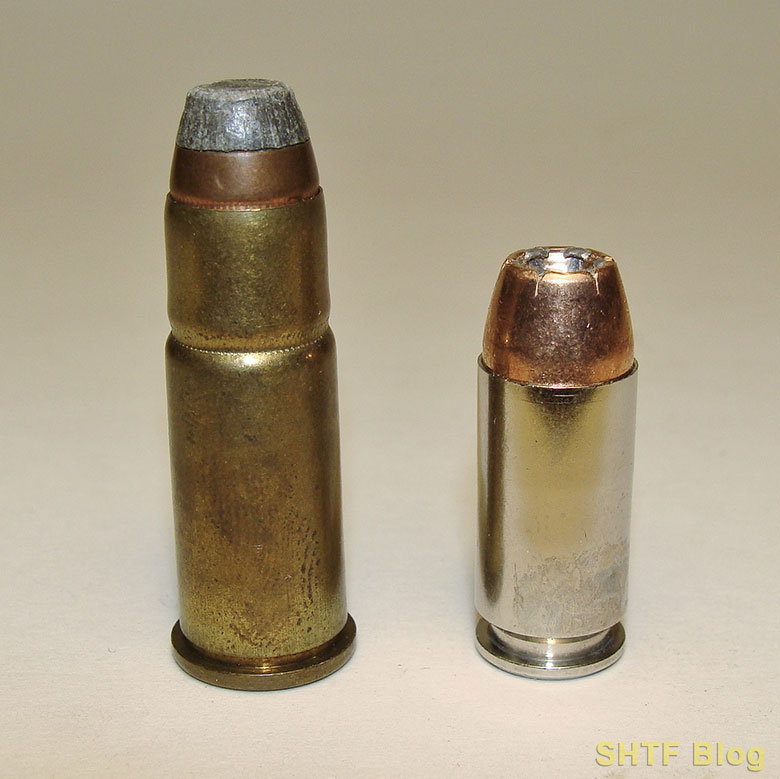
Let’s toss the .40 S&W into the way-back machine, dialed to 1874. Result? The ballistically identical .38 WCF, now better known as the .38-40. The latter’s true caliber is a misnomer since both fire the same .401/10mm-diameter bullets. Due to its compact dimensions and rimmed cartridge case, the .38-40 was a great match for revolvers and handy lever-action rifles.
Like its parent .44-40 cartridge introduced for Winchester’s “gun that won the west” – the Model 1873 – the necked-down .38-40 was well-timed for the western expansion of America. A smaller 32-20 version soon followed, and all three were quickly seized upon for dual use in single-action revolvers and lever guns.
This greatly simplified logistics for those living on the edge of civilization. And, since the bullets were made from lead, any recovered from game could even be recast and reloaded with simple and easily packable hand tools.
Although all three calibers endure, today’s more popular equivalents are the .357 Magnum and .44 Magnum – along with the legendary .45 Colt of M-1873 Peacemaker fame. And, unlike their slightly bottle-necked ancestors, the cases are straight-walled designs.
Thus, thanks to their rims, a .357 or .44 Magnum chamber can also safely fire the shorter .38 Special or .44 Special cartridges that spawned them – through firearms capable of feeding ‘em. That’s a non-issue for any revolver, along with single-shot rifles, and some of today’s lever-actions. Another big plus: Unlike the .40 S&W and other current pistol loads, the above Magnums exit carbine barrels at much higher velocities.
This puts them in an entirely different league, performance wise. Use a tough expanding bullet like the latest copper monolithics and some otherwise marginal game species could be taken – if necessary.
.357 Magnum Survival Gun Examination
If considering a dual-use caliber, the .357 Magnum has potential. The .44 Magnum (and .45 Colt) generally require larger-framed revolvers and, particularly regarding the .44 Magnum, recoil is more than most folks can effectively manage. Yes, S&W’s recent 5-shot Model 696 is built on a mid-sized L-frame, but it’s pretty feisty with full-house loads.
Thus, larger 6-shot N-frames have long been the standard for S&W’s double-action .44 Magnum and .45 Colt revolvers. Warmer .44 Special loads (if available) can reduce recoil, and some .45 Colt loads are manageable. Same for milder versions of the less common .41 Magnum, if you can track down ammo. Also, most are built on .44 Magnum frames.
However, the true mid-sized K-frame is a great host for a .357 Magnum – especially one destined for a steadier diet of standard and/or warmer +P .38 Special loads. The stainless 6-shot Model 66 features adjustable sights, and the shootable 4-inch version weighs a bit more than 36-ounces. That’s enough to soak up recoil without becoming a burden in a properly chosen holster.
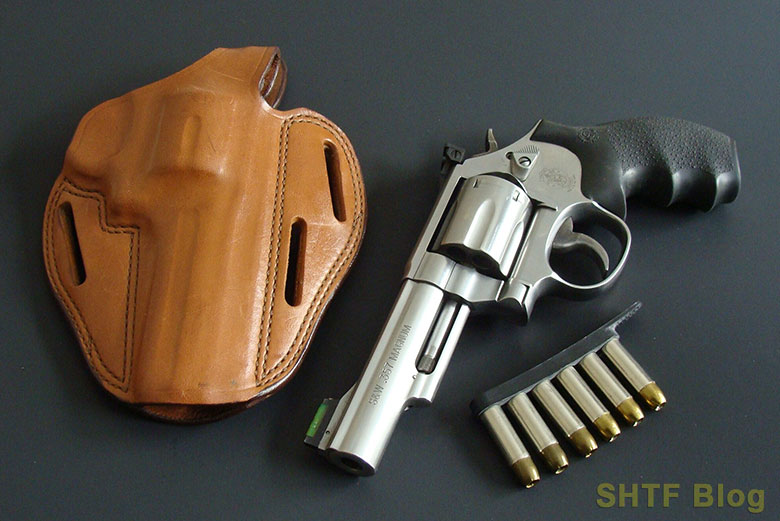
.357 Load Options
I’ve been shooting a lengthy list of .35-caliber cartridges for decades (to include the .357 Maximum, .35 Remington, .358 Winchester, .350 Remington Magnum, and probably, some others). Most have since departed, but the .357 Magnum has always been a keeper. The reason boils down to its versatility.
In an average-sized 4” revolver, the .357 Magnum has the power of today’s 10mm pistol loads. But unlike the latter, it can also digest warm but more tolerable .38 Special Plus-Ps, as well as standard-pressure .38 Special loads in a wide range of bullet designs and weights. Here’s a brief snapshot excerpted from my recent Top 10 Most Useful Cartridges post:
“Go with 130-grain .38 Spcl FMJs and you’ll have a useful practice and small game load. A simple switch to an expanding 125-grain +P (extra pressure) JHP will net a manageable defensive load. A jump to the .357 Magnum will provide enough power to take deer-sized game with careful shooting out to at least 50 yards – a pretty good poke for any handgun. But this distance can be doubled through a switch to a .357 Magnum rifle.
Unlike a 9mm, the .357 Mag gets a major velocity boost when fired in a carbine-length barrel. A standard-weight 158-grain JHP that averages around 1250 fps from a 4-inch revolver may reach or exceed 1750 fps in a handy 18-inch carbine. Using the latest tough expanding homogenous bullets, larger critters could be fair game in a pinch.”
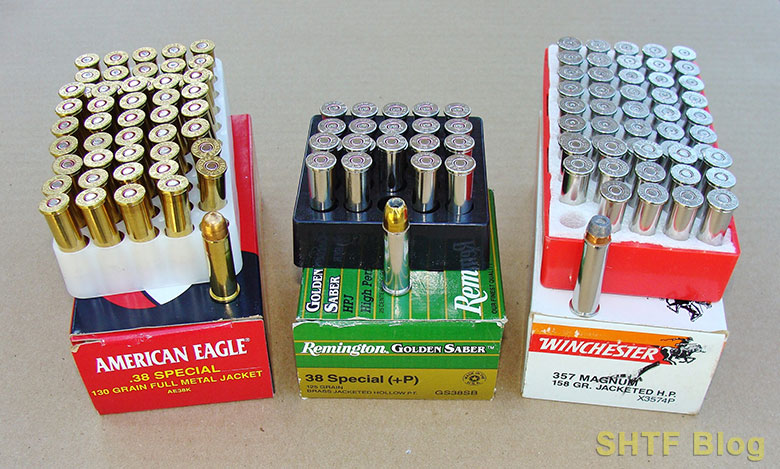
More About .357 Rifles
First, a caution for owners of rifles with tubular magazines: Due to the effects of recoil, bullets with sharper ogives (pointier tips) could detonate an adjacent primer. I fired the above mild-mannered .38 Special 130-grain FMJs through several Marlins with no ill effects, but maybe I was just lucky.
The more prudent option would be a flat point bullet, such as a common lead semi-wadcutter. No doubt, the above old-time loads featured flat-tipped bullets for this very reason.
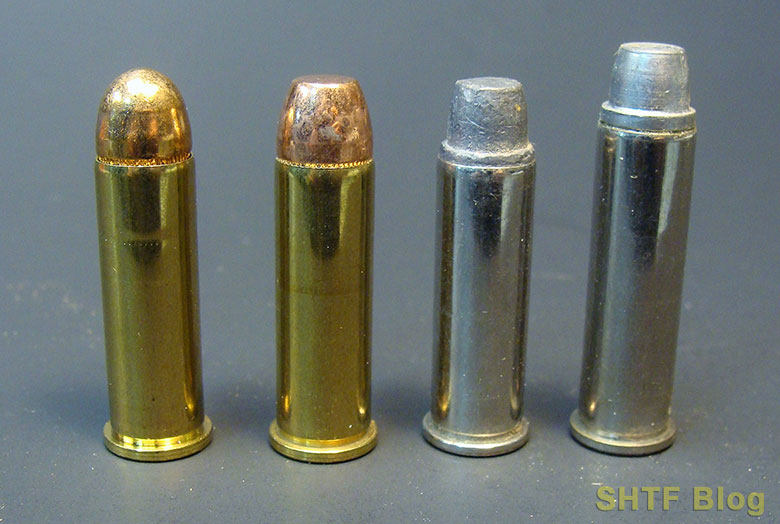
However, bullet noses are a non-issue in my present .357 magnum rifle simply because it’s a break-barreled single-shot. Nevertheless, like its lever-action .357s predecessors, the Rossi’s go-to load is “just” a .38 +P; Remington’s 125-grain brass-jacketed hollow-point Golden Saber (#GS38SB), fed via simple 6-round speed strips. GS served as our duty load for years and always performed well during FBI ballistic testing protocols.
Going a step further, I tried the same GS load on a deer with a 24” Marlin. Result: the bullet passed through the deer’s ribcage broadside from around 40 yards, leaving a classic deer-load exit hole. The buck was a smallish crotch-horn whitetail that field-dressed 135-pounds (live weight maybe, 160-ish). It ran around 50 yards and tipped over – the same effect I observe with the .243 Winchester.
Remington’s rated GS muzzle velocity of 975 fps is close to what we recorded from our 4-inch S&W M-65s, but it’s a whole different animal in a rifle. It clocks 1400 fps from the 21” barrel of my plain-Jane Rossi and reliably cuts sub two-inch 5-shot groups at 100 yards – a practical distance for this combination. All of this from a .38 Special.
As noted above, when fired through a rifle, the .357 Magnum boosts performance to an entirely new level – a notch below the new .350 Legend, but not by a huge amount. For deer-sized game, .357 Magnums are a better than .38 Special +Ps (I normally reserve the latter for critters through large varmints).
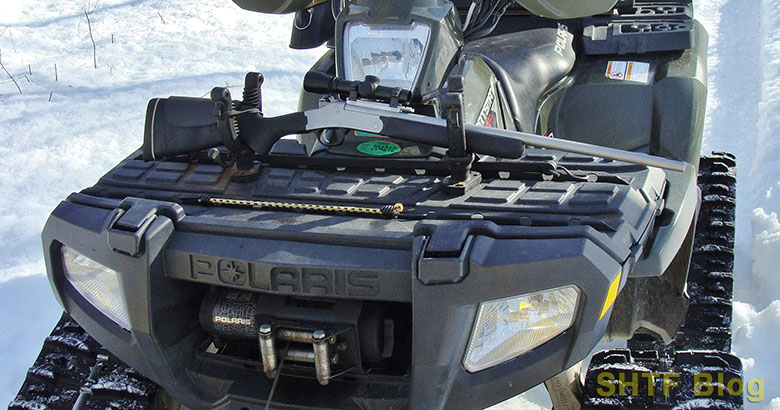
For the most part, my basic Rossi sees duty in the rack of an ATV, but it will easily disassemble to stow in small spaces. Today’s classier but still practical alternative is Henry’s Single Shot. And, since a lever-gun is a natural for this caliber, Henry’s Big Boy series is worth a look. Unlike some others (Winchester M-92 reproductions), the Henry’s will reliably feed .38 and .357 loads. Like the Marlins, they also feature solid-top receivers perfect for a low-powered scope or receiver sight.
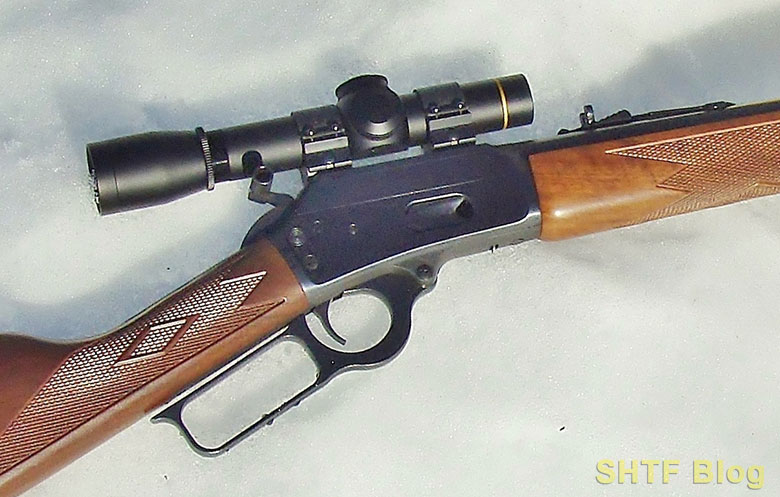

Marlins were a bit fussy with some .38 Special loads. Production has also ceased; however, Ruger has resurrected the line. So far though, no new .357 Magnums. And alas, Ruger’s bolt-action .357 has been discontinued. Like my Rossi, used H&R single shots are still in circulation and Traditions still catalogs a .357 Magnum.
Also, Rossi USA now lists an interesting stainless Winchester M-92 .357 clone that circumvents top-ejecting optics issues.
.357 Combo Takeaways
Regarding .357 handguns, I focused on S&W’s double-actions because of a lengthy relationship but, of course, there are plenty of other good makes from Ruger, Colt, etc. Single-action revolvers also see much use in wild places, particularly in the largest calibers. But a DA design can be reloaded a whole lot quicker (as in fast with speed-loaders or moon clips), making them better defensive choices.
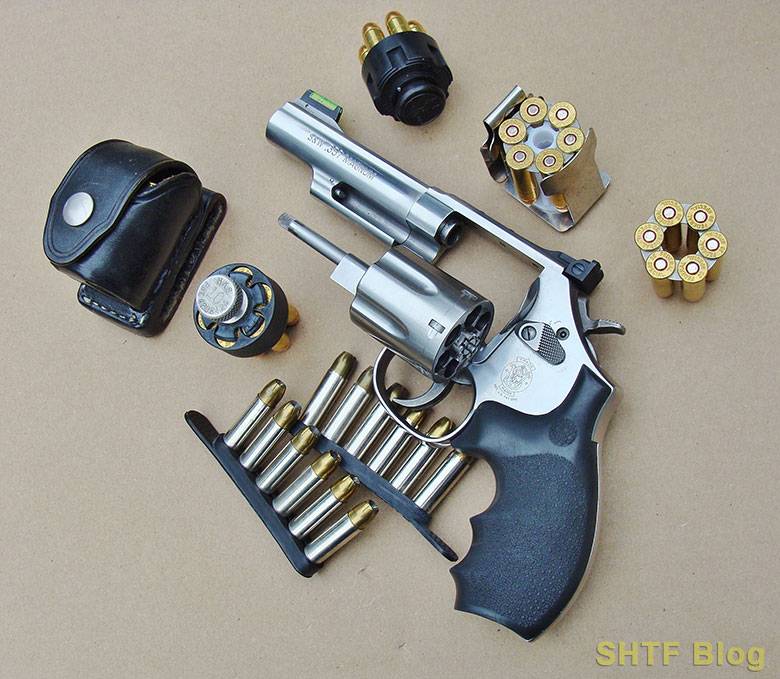
Further advantages? Consider these:
- Both systems are self-contained, eliminating concerns about expensive or lost magazines.
- No lost cases, either, unlike ejected pistol brass that will disappear in brush or snow.
- Meanwhile, those .38 or .357 cases can be reloaded, using a small and simple Lee kit.
- You could create (or buy) subsonic loads that’ll quietly function through suppressed lever-action or single-shot rifles.
- You could even make your own lead bullets over a campfire, using an inexpensive Lee bullet mold (no lubrisizer required).
- Smaller-sized cartridges use less powder and are easier to pack or carry.
- With practice, side-gated lever-action rifles can be topped off before running them dry.
- .357 Magnum revolvers and rifles are legal everywhere and can share the same ammo.
- When fired through a rifle (or carbine) .38 Specials are fairly quiet – producing considerably less noise than a 5.56.
- Although full-house .357 Magnums are noisier, they’re not overly concussive in carbines and recoil is fairly mild.
- The above system is also ambidextrous, a possible advantage for multiple users.
Seems to me like this two-gun system would be a good match for a remote cabin where the largest probable four-legged threat would be a black bear. In a pinch I’d tackle a moose with the .357 rifle and a Barnes copper, or Buffalo Bore hard-cast bullet.
Sights can be adjusted for different loads by counting clicks off a baseline choice (marked with a Sharpie Pen), or for elevation corrections, using a feeler gauge. Also, you can convert some .357 revolvers to use moon-clips, which won’t compromise their original function (did that to my M-66, gaining lightning fast reloads).
In closing, the same overall strategy will work with a .44 Magnum/.44 Special. Or, if you already happen to have one on hand, other options include the .41 Magnum and .45 Colt.

6 comments
You did not mention .38 shot shells which are handy for small game and do not test up the meat. also very easy to reload with minimum equipment. I agree the .38 combination is a good overall compromise. I have a Rossi 92 ad a S&W revolver. good article and the 12 gage is also great as a multi use firearm but big bulky ammo that is more difficult to reload.
Sigh, there is a major difference between “illicit’ and ‘elicit’ – you lose credibility when you misuse them.
Now that I got that off my editorial chest, the article made lots of valid points. I’ve been a proponent of the rifle/pistol battery for years (decades?). .357/.38 could very well be the best overall choice – due in large part to availability of ammo. Of course YMMV due to location (mentioned in the article) and perhaps a real world threat analysis and even financial constraints.
Yes, we know the difference, but typos sometimes make it past us. Our content is written by humans after all. Thanks.
That was an interesting and very informative article. It’s a lot to absorb in regards to makes and models and the ammunition they can use, but it’s a very thorough article. And this is a topic not discussed enough among preppers.
I agree with the “magazine-less” pistol and rifle or carbine concept in .22, 9mm and the .38/.357 combo. For those who desire a bit more power without feeling the punch of a rifle stock or as if their pistol was being ripped from their hands, the .357 offers that extra power.
The shooter also has the option of softer or hotter loads. I have fired a .45 caliber 19911 and would consider shooting the .357 magnum, but if I did not like the extra recoil, I could choose to shoot regular .38 loads or the plus loads. So I don’t loose money on a pistol I don’t want to shoot.
And there is the advantage of being able to use different ammunition and again, the owner/shooter can choose to have some of both for his pistol and the .357 for his rifle, but again, no matter what he has on hand or can acquire, he won’t be out of ammo.
Regardless of ammunition and if the firearm is a single shot, bolt, pump or lever action, or even semiauto, anything that doesn’t require a detachable box magazine reduces cost, weight we have to pack and the potential feeding issues if a magazine is damaged or the spring wears out. Granted, modern magazines generally work well and last a long time, but not having to buy mags reduces our costs and some firearms can be topped off. Using magazines will tend to make us think we have to keep buying more of them.
The advantage of fast reloads sounds good tactically, but in a doomsday scenario or a serious emergency, most of us will probably not be ripping off full mags worth and reloading unless we burn through our supply. Unless we are invaded, we won’t have to defend against hoards or waves of armed humans.
Another reason to go with .357/.38 would be the ability for others to handle the load too. You got into this a bit when you mentioned .44 caliber pairs. When I started shooting, I went with a .44 caliber pair. Unfortunately it was destroyed and once Ruger releases the 1894 I’ll be looking to replace them with a GP100 or Redhawk, and the 1894 lever action in .357. This allows for lighter loads that other family members can handle, where they can’t handle any full sized .44 load.
As mentioned regarding tube fed rifles, you need to be aware of bullet design. Of the bullets pictured, I’d probably stay away from that .38 FMJ just to be safe. But there is the Leverevolution rounds available which give a rifle profiled bullet that is safe in the tubular magazines.
Good points.